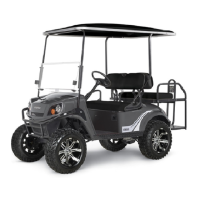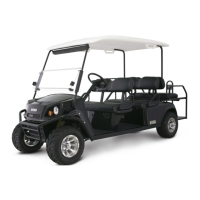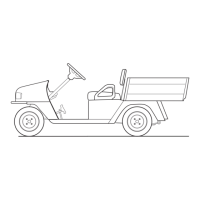Do you have a question about the Ezgo LIBERTY LSV and is the answer not in the manual?
Explains hazard symbols (DANGER, WARNING, CAUTION, NOTICE) for user safety.
Defines LSV standards (SAE J2358) and vehicle compliance with regulations.
Details about warranty coverage, limitations, exclusions, and how to register the vehicle.
Provides information and procedures for safe long-term storage of batteries.
Explains VIN plate locations and importance for ordering parts.
Details how to purchase service and parts manuals through the dealer.
Outlines owner's responsibility for vehicle use, preventing unauthorized access, and safety.
Specifies age and license requirements for operating the vehicle.
Highlights the importance of proper instruction and reading manuals/labels before use.
Advises against operating the vehicle while under the influence of alcohol or drugs.
Details passenger requirements for fitting the vehicle and securing seat belts.
Stresses the importance of wearing seat belts and proper positioning for safety.
States the maximum vehicle weight capacity and risks of exceeding it.
Explains the necessity of maintaining correct tire pressure for safe vehicle handling.
Provides general guidelines and warnings for safe vehicle operation.
Details safety precautions and requirements for operating with passengers.
Instructs on the correct method for using and positioning seat belts.
Provides instructions on how to safely load the vehicle with passengers and cargo.
Outlines necessary checks and procedures for safe reverse operation.
Advises against operating a damaged or malfunctioning vehicle until repaired.
Warns about the increased risk of loss of control at higher speeds.
Offers advice on safe turning techniques to prevent accidents and rollovers.
Provides guidelines for safely driving up hills, avoiding steep slopes.
Offers advice on safe downhill driving, focusing on brake control.
Emphasizes using correct tire size/type and maintaining proper inflation.
Gives precautions for operating on slippery surfaces to maintain traction.
Details safe ambient temperature ranges and procedures for battery charging.
Outlines safety precautions and procedures for lifting the vehicle.
Warns about risks and warranty voiding associated with vehicle modifications.
Provides essential safety rules to follow while performing vehicle maintenance.
Lists critical safety measures for performing vehicle maintenance.
Details safety labels found on the dash panel related to operation.
Explains the classification of the vehicle as a Low Speed Vehicle (LSV).
Provides instructions on the proper operation of the run/tow switch.
Details the vehicle's emission control information and certification.
States that the product may be covered by patents and provides a link for details.
Alerts users to dangers associated with high voltage components in the battery pack.
Provides safety instructions and procedures for towing the vehicle.
Alerts users to serious injury risks associated with maintenance and towing.
Warns about the risk of electric shock and necessary precautions.
Provides warnings and cautions for handling and using the Li-ion battery pack.
Explains the function of the four-position key switch for vehicle operation.
Describes the three-position switch for controlling headlights.
Explains the SOC meter's function in indicating battery power level.
Identifies the horn switch location and how to activate the horn.
Describes the locations and capacity of the vehicle's cup holders.
Details the USB port's power supply capabilities and potential battery drain.
Indicates the location of the battery charger port for recharging.
Explains the steering wheel's role in controlling the vehicle's direction.
Describes the location and use of the turn signal switch.
Explains the brake pedal's function for slowing and stopping the vehicle.
Details how the electronic parking brake (IntelliBrake™) operates and releases.
Describes the accelerator pedal's role in controlling vehicle speed and acceleration.
Identifies glove box and storage compartment locations for small items.
Describes optional overhead console features like infotainment and camera display.
Details the vehicle's 2-point lap seat belts and their mandatory use.
Explains the purpose of hip restraints to keep occupants positioned during movement.
Describes the seats' capacity and how they can be accessed for maintenance.
Explains the optional rearview mirror and its display of the camera image.
Details the adjustability of side mirrors for optimal visibility and blind spot checks.
Describes the windshield's features like vents and advises on cleaning methods.
Explains the OPS for occupant protection and the canopy for weather protection.
Provides critical warnings about operating the vehicle safely.
Lists essential checks and procedures before operating the vehicle for the first time.
Details the process of burnishing brake pads for optimal braking effectiveness.
Outlines a pre-ride inspection checklist to ensure safe operation.
Provides instructions and safety precautions for operating the battery charger.
Details the steps and precautions for using the off-board battery charger.
Describes the integrated on-board charger and its connection to batteries.
Explains how the speed control system works, including regenerative braking.
Details the pedal-up braking feature, which uses regenerative braking.
Explains the anti-stall feature that prevents motor damage.
Describes the feature that prevents acceleration when the key is turned on.
Explains the diagnostic mode that may reduce vehicle speed.
Provides guidance on proper seat belt use and inspection for safety.
Gives detailed instructions on how to correctly fasten and adjust seat belts.
Outlines the correct procedures for starting and stopping the vehicle.
Provides instructions for safely accelerating the vehicle.
Offers guidance on safe braking techniques for slowing or stopping.
Explains the vehicle's coasting feature and when to use brakes.
Details the step-by-step procedure for driving the vehicle safely.
Details safety precautions and requirements for operating with passengers.
Gives precautions for operating on slippery surfaces to maintain traction.
Provides guidelines for safely driving up hills, avoiding steep slopes.
Offers advice on safe downhill driving, focusing on brake control.
Outlines necessary checks and procedures for safe reverse operation.
Provides instructions for safely parking the vehicle on various surfaces.
Provides guidelines and critical warnings for towing the vehicle.
Provides essential safety rules to follow while performing vehicle maintenance.
Explains the importance of consistent inspection, adjustment, and lubrication.
Lists maintenance items, intervals, remarks, and corresponding pages.
Lists recommended lubricants and fluids for vehicle components.
Provides part numbers for various maintenance items like fuses and bulbs.
Outlines safety precautions and procedures for lifting the vehicle.
Provides detailed steps for safely lifting the front of the vehicle.
Provides detailed steps for safely lifting the rear of the vehicle.
Details the procedure for safely lowering the vehicle after lifting.
Provides advice on cleaning the vehicle to maintain its appearance and longevity.
Outlines the correct procedures and precautions for washing the vehicle.
Advises on the proper use of polishes and waxes for automotive finishes.
Covers tire maintenance, including size, type, pressure, and repair.
Explains the necessity of maintaining correct tire pressure for safe vehicle handling.
Details how to use tire plugs to repair small holes in the tire tread.
States that tire replacement requires specialized equipment and professional service.
Provides instructions for removing and installing vehicle wheels, including torque specs.
Advises on cleaning and replacing vehicle lights for optimal visibility.
Guides the user through the process of replacing a headlight assembly.
Details the procedure for replacing tail light and brake light assemblies.
Explains how to access and replace vehicle fuses.
Describes a test procedure for the controller system using vehicle movement.
Outlines the maintenance needed for the rear axle, including lubricant checks.
Provides warnings and essential information about the vehicle's hydraulic brake system.
Details the importance of using correct brake fluid and checking its level.
Provides critical safety warnings and handling instructions for the Li-ion battery pack.
Explains how to properly and safely dispose of lithium-ion batteries.
Offers guidance on maintenance for the battery charger.
Provides precautions and procedures for storing batteries to maintain capacity.
Outlines steps for preparing the vehicle for storage, including temperature and charge levels.
Explains how to determine and set the battery's state of charge for storage.
Details how to monitor the vehicle's state of charge during storage.
Advises against certain operations and charging in extreme low temperatures.
Details the steps to take to return the vehicle to service after storage.
Directs users to the appendix for information on diagnosing battery faults.
Provides warnings and precautions for safely transporting the vehicle.
Gives specific instructions and safety warnings for hauling the vehicle on a trailer.
Provides guidelines and critical warnings for towing the vehicle.
Details the procedure for manually releasing the IntelliBrake™ system.
Lists all technical specifications for the LIBERTY LSV.
A template for logging maintenance dates, technician, and services performed.
Provides safety and operating instructions for the QuiQ battery charger.
Details operating instructions, including LED indicators and extension cord usage.
Explains the meaning of the different LED indicators on the QuiQ charger.
Describes the receptacle display and its indications for charging status.
Provides a table for troubleshooting common charger faults based on LED flashes.
Explains hazard symbols (DANGER, WARNING, CAUTION, NOTICE) for user safety.
Defines LSV standards (SAE J2358) and vehicle compliance with regulations.
Details about warranty coverage, limitations, exclusions, and how to register the vehicle.
Provides information and procedures for safe long-term storage of batteries.
Explains VIN plate locations and importance for ordering parts.
Details how to purchase service and parts manuals through the dealer.
Outlines owner's responsibility for vehicle use, preventing unauthorized access, and safety.
Specifies age and license requirements for operating the vehicle.
Highlights the importance of proper instruction and reading manuals/labels before use.
Advises against operating the vehicle while under the influence of alcohol or drugs.
Details passenger requirements for fitting the vehicle and securing seat belts.
Stresses the importance of wearing seat belts and proper positioning for safety.
States the maximum vehicle weight capacity and risks of exceeding it.
Explains the necessity of maintaining correct tire pressure for safe vehicle handling.
Provides general guidelines and warnings for safe vehicle operation.
Details safety precautions and requirements for operating with passengers.
Instructs on the correct method for using and positioning seat belts.
Provides instructions on how to safely load the vehicle with passengers and cargo.
Outlines necessary checks and procedures for safe reverse operation.
Advises against operating a damaged or malfunctioning vehicle until repaired.
Warns about the increased risk of loss of control at higher speeds.
Offers advice on safe turning techniques to prevent accidents and rollovers.
Provides guidelines for safely driving up hills, avoiding steep slopes.
Offers advice on safe downhill driving, focusing on brake control.
Emphasizes using correct tire size/type and maintaining proper inflation.
Gives precautions for operating on slippery surfaces to maintain traction.
Details safe ambient temperature ranges and procedures for battery charging.
Outlines safety precautions and procedures for lifting the vehicle.
Warns about risks and warranty voiding associated with vehicle modifications.
Provides essential safety rules to follow while performing vehicle maintenance.
Lists critical safety measures for performing vehicle maintenance.
Details safety labels found on the dash panel related to operation.
Explains the classification of the vehicle as a Low Speed Vehicle (LSV).
Provides instructions on the proper operation of the run/tow switch.
Details the vehicle's emission control information and certification.
States that the product may be covered by patents and provides a link for details.
Alerts users to dangers associated with high voltage components in the battery pack.
Provides safety instructions and procedures for towing the vehicle.
Alerts users to serious injury risks associated with maintenance and towing.
Warns about the risk of electric shock and necessary precautions.
Provides warnings and cautions for handling and using the Li-ion battery pack.
Explains the function of the four-position key switch for vehicle operation.
Describes the three-position switch for controlling headlights.
Explains the SOC meter's function in indicating battery power level.
Identifies the horn switch location and how to activate the horn.
Describes the locations and capacity of the vehicle's cup holders.
Details the USB port's power supply capabilities and potential battery drain.
Indicates the location of the battery charger port for recharging.
Explains the steering wheel's role in controlling the vehicle's direction.
Describes the location and use of the turn signal switch.
Explains the brake pedal's function for slowing and stopping the vehicle.
Details how the electronic parking brake (IntelliBrake™) operates and releases.
Describes the accelerator pedal's role in controlling vehicle speed and acceleration.
Identifies glove box and storage compartment locations for small items.
Describes optional overhead console features like infotainment and camera display.
Details the vehicle's 2-point lap seat belts and their mandatory use.
Explains the purpose of hip restraints to keep occupants positioned during movement.
Describes the seats' capacity and how they can be accessed for maintenance.
Explains the optional rearview mirror and its display of the camera image.
Details the adjustability of side mirrors for optimal visibility and blind spot checks.
Describes the windshield's features like vents and advises on cleaning methods.
Explains the OPS for occupant protection and the canopy for weather protection.
Provides critical warnings about operating the vehicle safely.
Lists essential checks and procedures before operating the vehicle for the first time.
Details the process of burnishing brake pads for optimal braking effectiveness.
Outlines a pre-ride inspection checklist to ensure safe operation.
Provides instructions and safety precautions for operating the battery charger.
Details the steps and precautions for using the off-board battery charger.
Describes the integrated on-board charger and its connection to batteries.
Explains how the speed control system works, including regenerative braking.
Details the pedal-up braking feature, which uses regenerative braking.
Explains the anti-stall feature that prevents motor damage.
Describes the feature that prevents acceleration when the key is turned on.
Explains the diagnostic mode that may reduce vehicle speed.
Provides guidance on proper seat belt use and inspection for safety.
Gives detailed instructions on how to correctly fasten and adjust seat belts.
Outlines the correct procedures for starting and stopping the vehicle.
Provides instructions for safely accelerating the vehicle.
Offers guidance on safe braking techniques for slowing or stopping.
Explains the vehicle's coasting feature and when to use brakes.
Details the step-by-step procedure for driving the vehicle safely.
Details safety precautions and requirements for operating with passengers.
Gives precautions for operating on slippery surfaces to maintain traction.
Provides guidelines for safely driving up hills, avoiding steep slopes.
Offers advice on safe downhill driving, focusing on brake control.
Outlines necessary checks and procedures for safe reverse operation.
Provides instructions for safely parking the vehicle on various surfaces.
Provides guidelines and critical warnings for towing the vehicle.
Provides essential safety rules to follow while performing vehicle maintenance.
Explains the importance of consistent inspection, adjustment, and lubrication.
Lists maintenance items, intervals, remarks, and corresponding pages.
Lists recommended lubricants and fluids for vehicle components.
Provides part numbers for various maintenance items like fuses and bulbs.
Outlines safety precautions and procedures for lifting the vehicle.
Provides detailed steps for safely lifting the front of the vehicle.
Provides detailed steps for safely lifting the rear of the vehicle.
Details the procedure for safely lowering the vehicle after lifting.
Provides advice on cleaning the vehicle to maintain its appearance and longevity.
Outlines the correct procedures and precautions for washing the vehicle.
Advises on the proper use of polishes and waxes for automotive finishes.
Covers tire maintenance, including size, type, pressure, and repair.
Explains the necessity of maintaining correct tire pressure for safe vehicle handling.
Details how to use tire plugs to repair small holes in the tire tread.
States that tire replacement requires specialized equipment and professional service.
Provides instructions for removing and installing vehicle wheels, including torque specs.
Advises on cleaning and replacing vehicle lights for optimal visibility.
Guides the user through the process of replacing a headlight assembly.
Details the procedure for replacing tail light and brake light assemblies.
Explains how to access and replace vehicle fuses.
Describes a test procedure for the controller system using vehicle movement.
Outlines the maintenance needed for the rear axle, including lubricant checks.
Provides warnings and essential information about the vehicle's hydraulic brake system.
Details the importance of using correct brake fluid and checking its level.
Provides critical safety warnings and handling instructions for the Li-ion battery pack.
Explains how to properly and safely dispose of lithium-ion batteries.
Offers guidance on maintenance for the battery charger.
Provides precautions and procedures for storing batteries to maintain capacity.
Outlines steps for preparing the vehicle for storage, including temperature and charge levels.
Explains how to determine and set the battery's state of charge for storage.
Details how to monitor the vehicle's state of charge during storage.
Advises against certain operations and charging in extreme low temperatures.
Details the steps to take to return the vehicle to service after storage.
Directs users to the appendix for information on diagnosing battery faults.
Provides warnings and precautions for safely transporting the vehicle.
Gives specific instructions and safety warnings for hauling the vehicle on a trailer.
Provides guidelines and critical warnings for towing the vehicle.
Details the procedure for manually releasing the IntelliBrake™ system.
Lists all technical specifications for the LIBERTY LSV.
A template for logging maintenance dates, technician, and services performed.
Provides safety and operating instructions for the QuiQ battery charger.
Details operating instructions, including LED indicators and extension cord usage.
Explains the meaning of the different LED indicators on the QuiQ charger.
Describes the receptacle display and its indications for charging status.
Provides a table for troubleshooting common charger faults based on LED flashes.
| Brand | Ezgo |
|---|---|
| Model | LIBERTY LSV |
| Category | Utility Vehicle |
| Language | English |











